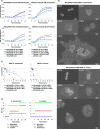Matching amino acids membrane preference profile to improve activity of antimicrobial peptides
- PMID: 36347951
- PMCID: PMC9643456
- DOI: 10.1038/s42003-022-04164-4
Matching amino acids membrane preference profile to improve activity of antimicrobial peptides
Abstract
Antimicrobial peptides (AMPs) are cationic antibiotics that can kill multidrug-resistant bacteria via membrane insertion. However, their weak activity limits their clinical use. Ironically, the cationic charge of AMPs is essential for membrane binding, but it obstructs membrane insertion. In this study, we postulate that this problem can be overcome by locating cationic amino acids at the energetically preferred membrane surface. All amino acids have an energetically preferred or less preferred membrane position profile, and this profile is strongly related to membrane insertion. However, most AMPs do not follow this profile. One exception is protegrin-1, a powerful but neglected AMP. In the present study, we found that a potent AMP, WCopW5, strongly resembles protegrin-1 and that the match between its sequence and the preferred position profile closely correlates with its antimicrobial activity. One of its derivatives, WCopW43, has antimicrobial activity comparable to that of the most effective AMPs in clinical use.
© 2022. The Author(s).
Conflict of interest statement
The authors declare no competing interests.
Figures




Similar articles
-
The biological role of charge distribution in linear antimicrobial peptides.Expert Opin Drug Discov. 2023 Mar;18(3):287-302. doi: 10.1080/17460441.2023.2173736. Epub 2023 Feb 17. Expert Opin Drug Discov. 2023. PMID: 36720196
-
Interaction between Antimicrobial Peptide Magainin 2 and Nonlipid Components in the Bacterial Outer Envelope.J Phys Chem B. 2022 Jul 28;126(29):5473-5480. doi: 10.1021/acs.jpcb.2c02768. Epub 2022 Jul 13. J Phys Chem B. 2022. PMID: 35829704
-
Atomic-Resolution Structures and Mode of Action of Clinically Relevant Antimicrobial Peptides.Int J Mol Sci. 2022 Apr 20;23(9):4558. doi: 10.3390/ijms23094558. Int J Mol Sci. 2022. PMID: 35562950 Free PMC article. Review.
-
The design of cell-selective tryptophan and arginine-rich antimicrobial peptides by introducing hydrophilic uncharged residues.Acta Biomater. 2022 Nov;153:557-572. doi: 10.1016/j.actbio.2022.09.028. Epub 2022 Sep 14. Acta Biomater. 2022. PMID: 36115654
-
Tryptophan, more than just an interfacial amino acid in the membrane activity of cationic cell-penetrating and antimicrobial peptides.Q Rev Biophys. 2022 Aug 18;55:e10. doi: 10.1017/S0033583522000105. Q Rev Biophys. 2022. PMID: 35979810 Review.
Cited by
-
Possible Molecular Mechanisms Underlying the Decrease in the Antibacterial Activity of Protamine-like Proteins after Exposure of Mytilus galloprovincialis to Chromium and Mercury.Int J Mol Sci. 2023 May 26;24(11):9345. doi: 10.3390/ijms24119345. Int J Mol Sci. 2023. PMID: 37298297 Free PMC article.
-
Insights into the Adsorption Mechanisms of the Antimicrobial Peptide CIDEM-501 on Membrane Models.Antibiotics (Basel). 2024 Feb 8;13(2):167. doi: 10.3390/antibiotics13020167. Antibiotics (Basel). 2024. PMID: 38391553 Free PMC article.
References
-
- Willyard C. The drug-resistant bacteria that pose the greatest health threats. Nature. 2017;543:15. - PubMed
-
- Falagas ME, Kasiakou SK. Colistin: the revival of polymyxins for the management of multidrug-resistant gram-negative bacterial infections. Clin. Infect. Dis. 2005;40:1333–1341. - PubMed
-
- Porter EA, Weisblum B, Gellman SH. Use of parallel synthesis to probe structure-activity relationships among 12-helical α-peptides: evidence of a limit on antimicrobial activity. J. Am. Chem. Soc. 2005;127:11516–11529. - PubMed
Publication types
MeSH terms
Substances
LinkOut - more resources
Full Text Sources

